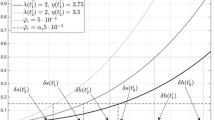Abstract
Railway track irregularities need to be kept at a satisfactory level by taking appropriate maintenance activities. This paper aims at obtaining an optimal maintenance schedule for improving the railway track irregularities using all-integer linear programming (AILP) optimization model analyses.
Firstly, we try to predict a change of surface irregularities by investigating the transition process through degradation and restoration model analyses. Then we develop an AILP model for obtaining an optimal schedule of multiple tie tamper (MTT) operation. The model takes both maintenance costs and the level of surface irregularities that reflects riding quality and safety into account, then finally gives an optimal tamping schedule of MTT for the whole year. Then we apply the results of this model to solve the optimal MTT’s maintenance scheduling problem for the actual railway network system and show that it is effective and useful enough by comparing our model results with actual existing data.
Similar content being viewed by others
References
T. Nagafuji, Trends in decision support system for track maintenance and key technologies. RTRI REPORT,12 (1995), 1–6.
H. Takai and M. Miwa, The state of developing the decision support system for track maintenance. JREA,7 (1999), 11–13.
M. Miwa, T. Ishikawa and T. Oyama, Basic study to construct the model for deterioration and restoration of track states (in Japanese). J-Rail98, Tokyo, 1998.
M. Miwa, T. Ishikawa and T. Oyama, Modeling the transition process of railway track irregularity and its application to the decision making for maintenance strategy. WCRR’99, Tokyo, 1999.
M. Miwa, T. Ishikawa and T. Oyama, Modeling the transition process of track irregularity and its application to the multiple tie tamper operation (in Japanese). J-Rail99, Tokyo, 1999.
M. Miwa, T. Ishikawa and T. Oyama, Modeling the transition process of railway track irregularity and its application to the optimal decision-making for multiple tie tamper operations. Railway Engineering 2000, London, 2000.
M. Miwa, T. Ishikawa and T. Oyama, Modeling the transition process of railway track irregularity and all integer mathematical programming model analyses for making optimal track maintenance schedule (in Japanese). Journals of the Japan Society of Civil Engineering,IV-52 (2001), 51–65.
R.G. Brown, Statistical Forecasting for Inventory Control. 1959.
M. Miwa, T. Ishikawa and T. Oyama, Modeling the optimal decision-making multiple tie tamper operations. WCRR2001, Koeln, 2001.
M. Miwa, T. Ishikawa, Y. Okumura and T. Oyama, Modeling the optimal MTT operation schedule and its application to Japanese railway network system. Railway Engineering 2002, London, 2002.
M. Miwa and M. Uchida, Planning best strategy for track maintenance by branch & bound method. Proceeding of the 20th Conference of Infrastructure Planning, 1997, 55–58.
M. Miwa and T. Oyama, All-integer type linear programming model analyses for the optimal railway track maintenance scheduling. OPESEARCH, Operational Research Society of India,41, No. 3 (2004), 35–45.
R. Wallace, Train scheduling — Migration of manual methods to scalable computer platforms, computer-aided transit scheduling. Proceedings of the Six International Workshop on Computer-Aided Transit Scheduling of Public Transport (eds. J.R. Daduna, I. Branco and J.M. Pinto Paixao), 1995, 321–333.
E.P. Margaret, A. Wren and R.S.K. Kwan, Modeling the scheduling of train drivers, computer-aided transit scheduling. Proceedings of the Six International Workshop on Computer-Aided Transit Scheduling of Public Transport (eds. J.R. Daduna, I. Branco and J.M. Pinto Paixao), 1995, 359–370.
M.S. Daskin and S.H. Owen, Location models in transportation. Handbook of Transportation Science (2nd edition, ed. R.W. Hall). Kluwer Academic Publishers, 2002, 320–371.
C. Barnhart, A.M. Cohn, E.L. Johnson, D. Klabjan, G.L. Nemhauser and P.H. Vance, Handbook of Transportation Science (2nd edition, ed. R.W. Hall). Kluwer Academic Publishers, 2002, 517–560.
Author information
Authors and Affiliations
Corresponding author
About this article
Cite this article
Oyama, T., Miwa, M. Mathematical modeling analyses for obtaining an optimal railway track maintenance schedule. Japan J. Indust. Appl. Math. 23, 207 (2006). https://doi.org/10.1007/BF03167551
Received:
DOI: https://doi.org/10.1007/BF03167551




